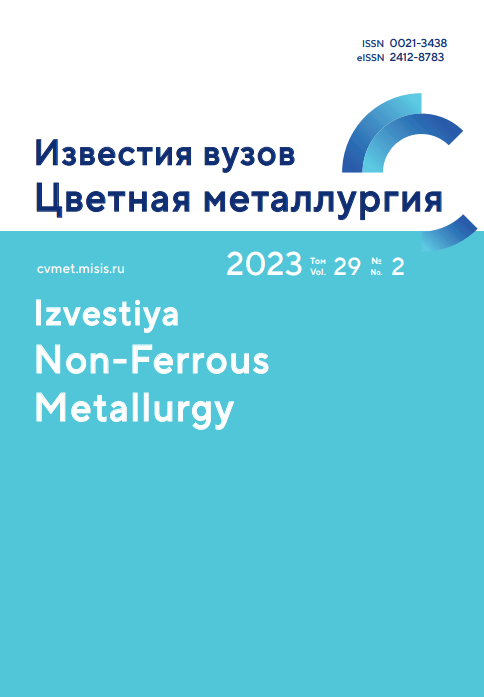
Izvestiya. Non-Ferrous Metallurgy (In Russian - Izvestiya vuzov. Tsvetnaya metallurgiya) is a scientific peer-reviewed open-access periodical. It has been published since 1958.
The journal accepts the following types of manuscripts: research articles based on original studies, review articles, short communications, as well as materials from conference reports and other scientific events.
The journal publishes scientific materials dedicated to the following aspects of the theory and scientifically grounded practice of non-ferrous metallurgy:
– Mineral Processing of Nonferrous Metals
– Metallurgy of Nonferrous Metals
– Metallurgy of Rare and Precious Metals
– Pressure Treatment of Metals
– Physical Metallurgy and Heat Treatment
– Corrosion and Protection of Metals
A considerable volume of articles published in the journal relates to priority areas of science, technology and engineering development, such as the industry of nanosystems and materials, rational nature management, energy and energy saving.
The target author and readership of the journal are metallurgists, material scientists, physicists, chemists, employees of higher education, representatives of the Russian Academy of Sciences and other specialists from all over the world.
The journal accepts manuscripts that comply with the Ethics of Scientific Publications and the Author Guidelines. Manuscripts that pass the initial editorial evaluation are sent for peer review.
Submitted manuscripts undergo a double-blind peer review process to ensure impartial and high-quality assessment of submitted work.
The journal is published 4 times a year.
The journal is published in print (ISSN 0021-3438) and electronic (ISSN 2412-8783) formats.
Subscription to the journal in both print and electronic formats is available through the "Ural-Press" agency.
Since 2013, published articles in the journal have been assigned a DOI (prefix 10.17073).
The founder and publisher of the journal is the National University of Science and Technology "MISIS" (Moscow, Russian Federation).
The journal is registered in Russian Federation as a mass media outlet with the Federal Service for Supervision of Communications, Information Technology, and Mass Media (Registration Certificate PI № FS 77-79229 dated September 25, 2020).
Until 2022 inclusive, the articles from the journal Izvestiya. Non-Ferrous Metallurgy were translated into English and published in the Russian Journal of Non-Ferrous Metals by Pleiades Publishing.
Since 2023, the journal is published in two languages simultaneously – in Russian and English – and no longer transfers articles to a foreign publisher. The print version is issued exclusively in Russian, with metadata provided in English, while the electronic version is published in a mirrored format in both Russian and English.
The journal is indexed in international databases such as Chemical Abstracts (Online), INIS Collection Search (International Nuclear Information System), and OCLC ArticleFirst. It is also registered in the international directory of periodicals, Ulrich's Periodicals Directory. The journal is included in the bibliographic database RINTs (Russian Index of Science Citation) and the Russian Science Citation Index collection. The journal is listed in the White List of Scholarly Journals (the information resource of the Russian Center for Scientific information) and the List of the Higher Attestation Commission (HAC) of the Russian Federation.
Current issue
Metallurgy of Nonferrous Metals
Metallurgy of Rare and Precious Metals
Announcements
2024-10-22
Пост-релиз Конгресса и Выставки «Цветные металлы и минералы-2024»
С 9 по 13 сентября в Красноярске состоялся ХII Международный Конгресс и Выставка «Цветные металлы и Минералы – 2024». На площадке Конгресса собрались порядка 800 участников - представители более 200 компаний и научных организаций из 11 стран мира.
В рамках Программы Конференции заседали следующие секции:
- Производство глинозема;
- Получение алюминия;
- Углеродные материалы;
- Литейные технологии и новые материалы;
- Обработка давлением алюминия и его сплаво;
- Металловедение алюминия и его сплавов – «Биронтовские чтения»;
- Минерально-сырьевая база цветных и благородных металлов
- Технологии обогащения руд цветных, редких и благородных металлов;
- Металлургия цветных металлов;
- Металлургия благородных металлов;
- Металлургия редких металлов.
Всего было сделано 220 докладов.
Основной площадкой для установления новых деловых связей, обсуждения вариантов взаимовыгодного сотрудничества стала Промышленная выставка, где более 50 компаний-экспонентов представили последние инновации и достижения в горно-металлургической отрасли.
Журнал «Известия вузов. Цветная металлургия» выступил информационным партнером выставки и представил участникам последние выпуски и информационные буклеты. Участие в выставке позволило широкой аудитории познакомиться с нашим журналом.
Мы всегда стремимся участвовать в ключевых мероприятиях металлургического комплекса. Рады были принять участие в ХII Международном Конгрессе и Выставке «Цветные металлы и Минералы – 2024» и надеемся на дальнейшее плодотворное сотрудничество и партнерство!
| More Announcements... |


































